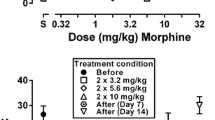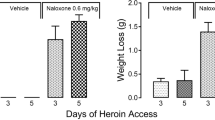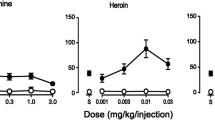Abstract
This study was conducted to characterize the opiate dependence potential of a number of opiate and non-opiate psychoactive drugs in morphine-dependent cynomolgus monkeys (Macaca fascicularis). In addition, the agonist/antagonist profiles of buprenorphine and butorphanol were directly compared. Six male cynomolgus monkeys were maintained on morphine (3.0 mg/kg, q.i.d.) for 6 months. On evaluation days, monkeys were scored for opiate withdrawal signs 18 h after the last dose of morphine. Single dose suppression studies were conducted by giving subcutaneous injections of morphine (3 or 6 mg/kg), naloxone (0.01, 0.05 or 0.1 mg/kg), buprenorphine (1, 3, 10, 30 or 100 µg/kg), butorphanol (0.01, 0.1, 1.0 or 3.2 mg/kg), haloperidol (0.01, 0.05 or 0.1 mg/kg), imipramine (2, 5 or 10 mg/kg) or saline and measuring the number and frequency of withdrawal signs that appeared over a 2-h period. In a separate precipitation experiment either saline or 0.01 or 0.1 mg/kg butorphanol was administered 2 h after the last maintenance dose of morphine. In the single dose suppression test, morphine completely suppressed most withdrawal signs while naloxone increased the severity of withdrawal. All doses of buprenorphine increased many withdrawal signs such as backward gait, rearing, chafing face, chain biting, vomiting, masturbation, and vocalizations after intimidation. Only a few signs were reduced, but the overall withdrawal scores were not significantly increased. Low doses of butorphanol suppressed some signs while the highest dose almost completely eliminated all withdrawal signs. Butorphanol also failed to precipitate opiate withdrawal, and actually reversed the signs present in the saline-treated monkeys. Imipramine and haloperidol had little effect on the morphine withdrawal syndrome. These data suggest buprenorphine exerts only opioid antagonistic activity and butorphanol exerts only opioid agonistic activity over a wide range of doses studied in morphine-dependent cynomolgus monkeys.
Similar content being viewed by others
References
Aceto MD (1984) Characterization of prototypical opioid antagonists, agonist-antagonist, and agonists in the morphine-dependent rhesus monkey. Neuropeptides 5:15–18
Aceto MD (1990) Assessment of physical dependence techniques for the evaluation of abused drugs. In Adler MW, Cowan A (eds) Testing and evaluation of drugs of abuse (Modern Methods in Pharmacology, Vol. 6). Wiley-Liss, New York, pp 67–79
Aceto MD, Harris LS (1985) Cynomolgus monkeys and morphine tolerance and dependence. Drug Alcohol Depend 15:15–18
Aceto MD, Carchman, RA, Harris LS, Flora RE (1978) Caffeine elicited withdrawal signs in morphine dependent monkeys. Eur J Pharmacol 50:203–207
Dum J, Blasig J, Herz A (1981) Buprenorphine: demonstration of physical dependence liability. Eur J Pharmacol 70:293–300
Fudala PJ, Johnson RE (1989) Abrupt withdrawal of buprenorphine following chronic administration. Clin Pharmacol Ther 45:186
Horan P, Ho IK (1989) Butorphanol precipitates abstinence in morphine dependent rats. Eur J Pharmacol 170:265–268
Horan P, Ho IK (1991) The physical dependence liability of butorphanol: a comparative study with morphine. Eur J Pharmacol 203:387–391
Jasinski DR, Pevnick JS, Griffith JD (1978) Human pharmacology and abuse potential of the analgesic buprenorphine: a potential agent for treating narcotic addiction. Arch Gen Psychiatry 35:501–516
Lukas SE, Griffiths RR (1982) Precipitated withdrawal by a benzodiazepine receptor antagonist (Ro 15-1788) after 7 days of diazepam. Science 217:1161–1163
Lukas SE, Griffiths RR (1984) Precipitated diazepam withdrawal in baboons: effects of dose and duration of diazepam exposure. Eur J Pharmacol 100:163–171
McCarthy PS, Howlett GJ (1984) Physical dependence induced by opiate partial agonists in the rat. Neuropeptides 5:11–14
Neil A, Terenius L, Ternes JW, Ehrman RN, O'Brien CP (1986) Opiate receptors, neuropeptides in CNS and CSF of two Macaca species with different responsiveness to opiates. Eur J Pharmacol 122:143–147
Preston KL, Bigelow GE, Liebson IA (1988) Butorphanol-precipitated withdrawal in opioid-dependent human volunteers. J Pharmacol Exp Ther 246:441–448
Seevers MH (1936) Opiate addiction in monkey. 1. Methods of study. J Pharmacol Exp Ther 56:147–156
Seevers MH, Deneau GA (1963) Physiological aspects of tolerance and physical dependence. In: Root WS, Hofmann FG (eds) Physiological pharmacology. Academic Press, New York, pp 565–640
Villarreal JE, Karbowski MG (1974) The actions of narcotic antagonist in morphine-dependent rhesus monkeys. In: Braude MC, Harris LS, May EL, Smith JP, Villarreal JE (eds) Narcotic antagonists (Advances in Biochemical Psychopharmacology, Vol. 8). Raven Press, New York, pp 273–289
Woods JH (1985) Substitution and primary dependence studies in animals. Drug Alcohol Depend 14:233–247
Yanagita T, Katoh S, Wakasa Y, Oinuma N (1982) Dependence potential of buprenorphine studied in rhesus monkeys. In: Harris LS (ed) Problems of drug dependence. National Institute on Drug Abuse, Rockville, MD, pp 208–214
Author information
Authors and Affiliations
Rights and permissions
About this article
Cite this article
Fukase, H., Fukuzaki, K., Koja, T. et al. Effects of morphine, naloxone, buprenorphine, butorphanol, haloperidol and imipramine on morphine withdrawal signs in cynomolgus monkeys. Psychopharmacology 116, 396–400 (1994). https://doi.org/10.1007/BF02247468
Received:
Revised:
Issue Date:
DOI: https://doi.org/10.1007/BF02247468




